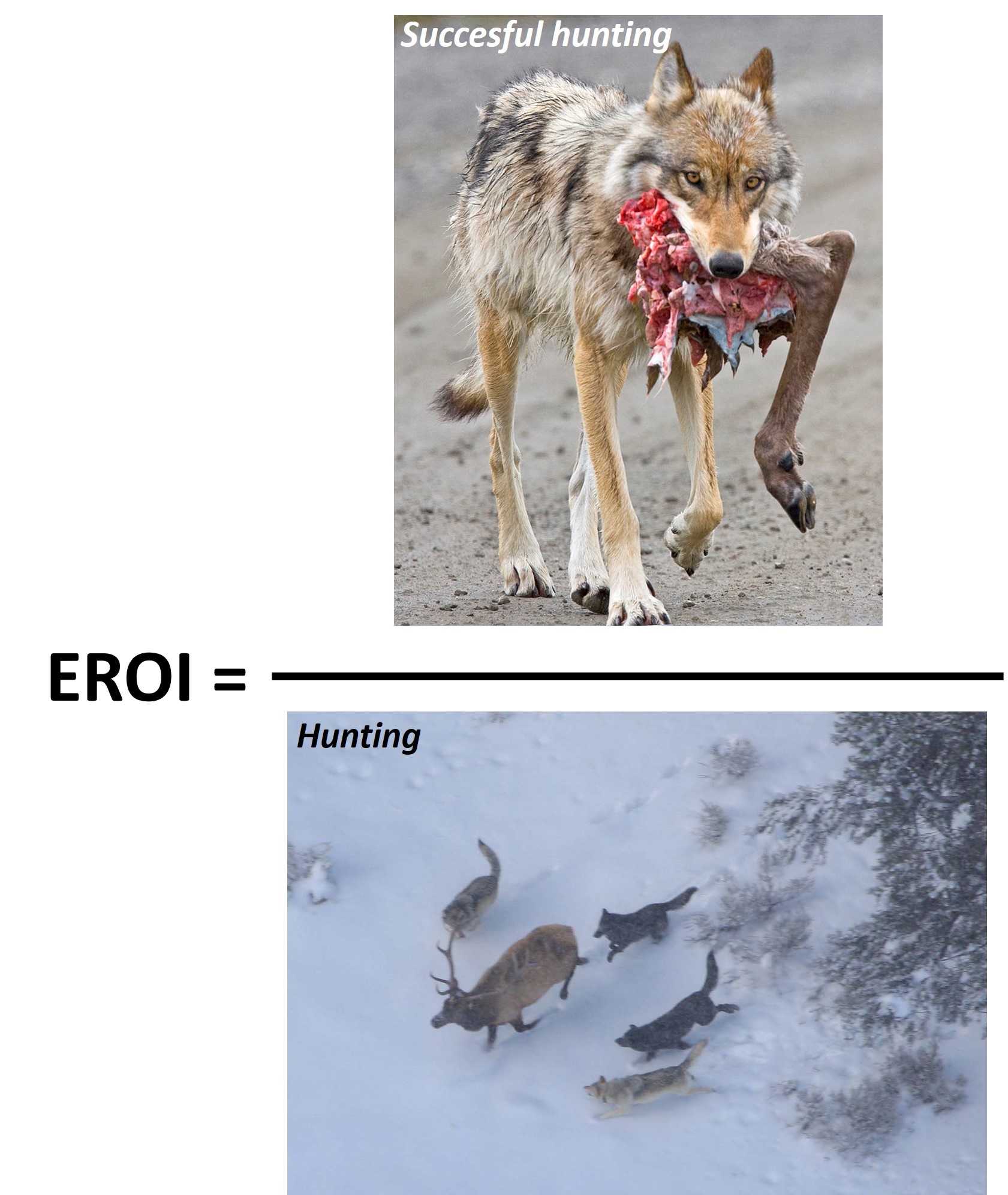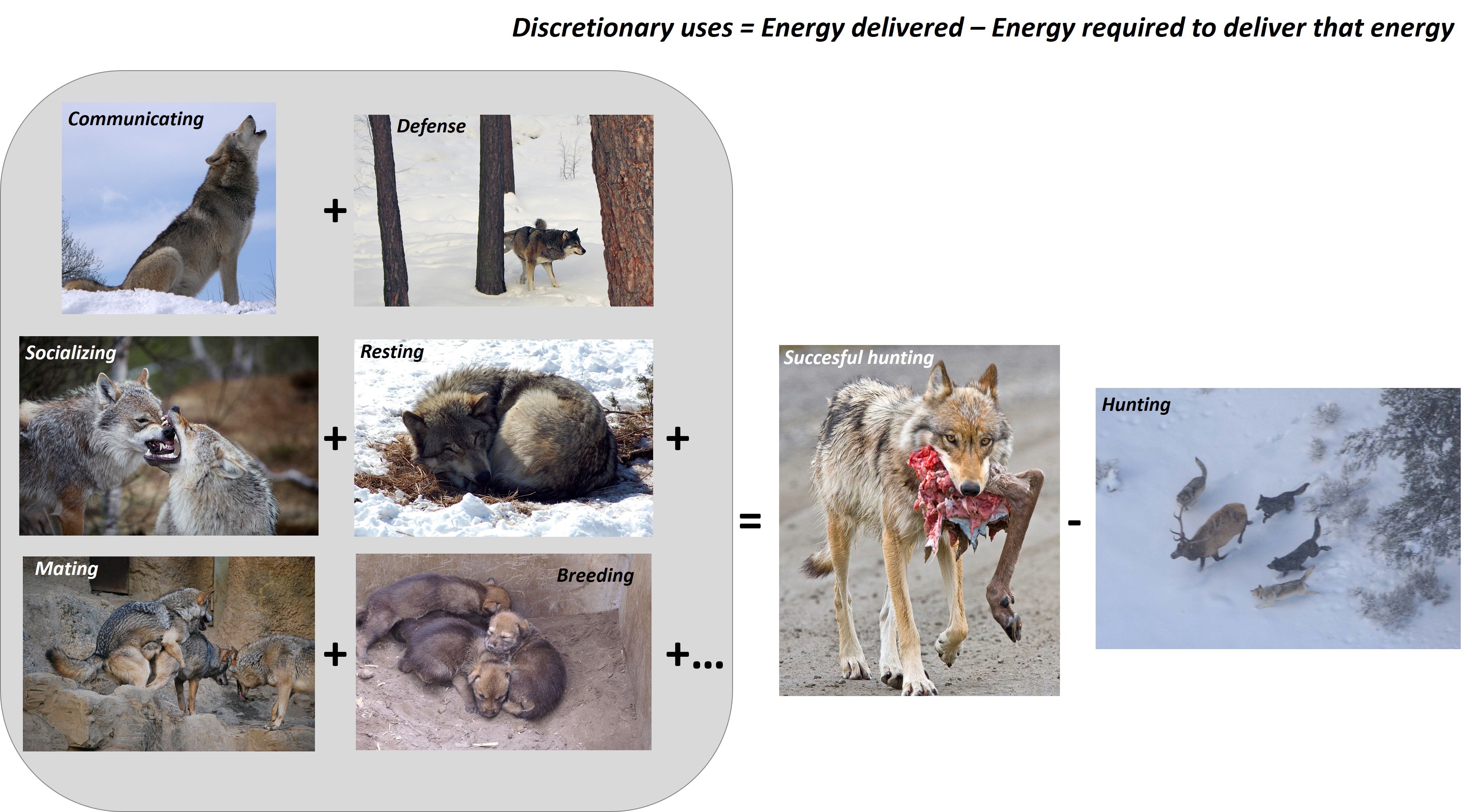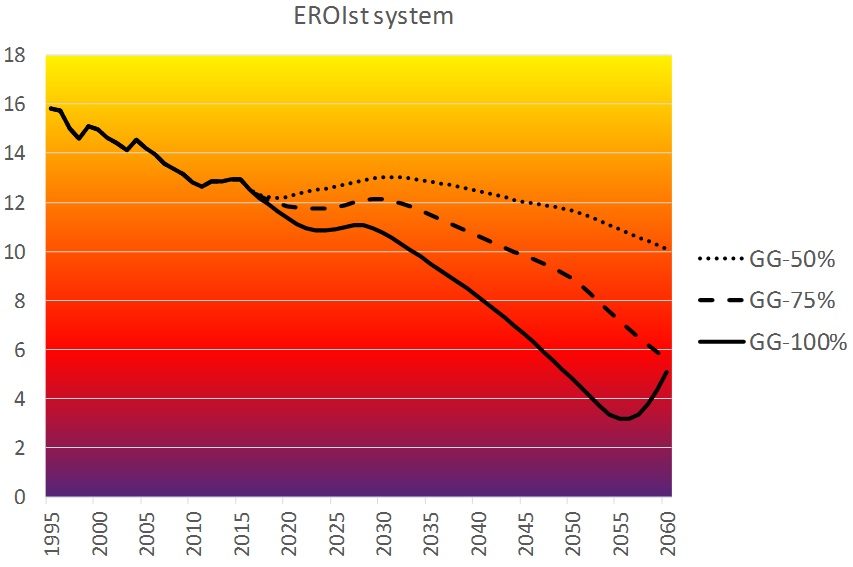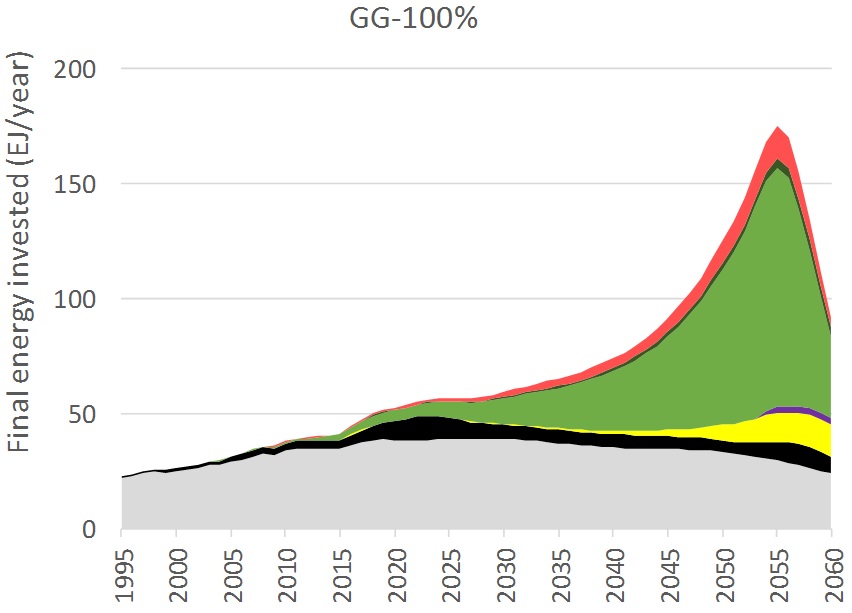The EROI (Energy Return On energy Invested) refers to the quotient of the total amount of energy flow that is delivered and the total amount of energy that needs to be invested to obtain that flow of energy. Mathematically, the EROI can be defined as

Favourable long-term values for this indicator (i.e., clearly greater than 1:1), have been identified in fields as diverse as biology and anthropology as a key driver of the increasing complexity and evolution of plants, animals, and human beings. A very intuitive example: if a wolf systematically invests more energy in hunting than that provided by the prey finally hunted, it will have no future. Further, a wolf needs to assure a sufficient amount of discretionary energy available even after subtracting the energy invested in hunting to survive and thrive (i.e., beyond maintaining his metabolism, communicating, socializing, resting, mating, breeding, etc. but also less pleasant activities such as defense). Similarly, during migrations, the place of arrival must offer a richer diet so that it can more than compensate for the loss of calories caused by the journey.

Simplified conceptual representation of the EROI (standard) of wolves. “Hunting” includes all energy spent in the failed attempts. Own composition from images from Wikimedia Commons: Successful hunting and Hunting.
CLICK ON THE IMAGE TO ENLARGE
|
This is of course dynamic in the sense that a wolf who got stuffed in summer may not survive the following winter, or a migratory bird will not make it if it lacks calories at one point in the middle of the migration and has not possibility to be fed…, i.e., the EROI rate should also always be greater than 1:1 over relatively short periods. Human societies do not escape this general law, although we have developed, especially in industrialized countries, many ways to enjoy all the categories from the discretionary uses (communicating, defense, socializing, resting, mating, breeding, etc.) while avoiding the issues of getting the useful energy (“hunting” in wolf terminology, i.e. extracting and transporting energy flows in human one), such as the division of labour and international trade.

Simplified conceptual representation of the energy for discretionary uses available for wolves after subtracting the energy spent in hunting to the energy got during the successful hunt. Note that depending on the interpretation of what encompasses the “energy required to deliver energy” (denominator of the EROI formula), different definitions can be set. In fact, a part of the energy invested during defense or resting could also be allocated to the energy invested to achieve successful hunting. These complexities in the allocation of energy investments are the root of pervasive discussions in the scientific literature for years. Own composition from images from
Wikimedia Commons:
Resting,
Defending,
Socializing,
Hunting,
Mating,
Breeding, and
Successful hunting.
CLICK ON THE IMAGE TO ENLARGE
|
Thus, the EROI is a common indicator in the literature used to evaluate the performance of different energy technologies and we should be able to predict their evolution during the energy transition to anticipate potential unfeasible scenarios. Capturing this phenomenon is also relevant given that the energy transition will require not only significant monetary investments, but also energy and mineral investments. In this sense, the MEDEAS models that we are developing at the GEEDS-UVa are one of the first simulation tools that allow us to dynamically, endogenously project the EROI of the entire energy system, as well as feedback its evolution to the rest of the system. Thus, this approach also makes it possible to detect potential situations in which a very rapid transition “drains” useful energy from the system in such a way that the energy it can enjoy is ultimately reduced. This situation is colloquially known as “energy trap”.
The importance of dynamic and endogenously computing the investments in energy and materials is illustrated by the simulation, within the integrated assessment model MEDEAS-World, of three scenarios with different objectives of transition of renewable energies in the global electricity mix (50%; 75% and 100%) by 2060 in a context of Green Growth (GG), which is an alternative paradigm frequently assumed to avoid the adverse impacts of global environmental change on human societies and is defended by institutions such as the EU, the OECD, and the World Bank.
The methodology developed and the results obtained have been recently published in the scientific journal Energy Strategy Reviews in the article "Dynamic Energy Return on Energy Investment (EROI) and material requirements in scenarios of global transition to renewable energies".
The results obtained in this work show that achieving high levels of renewable electricity penetration globally by 2060 according to the Green Growth narrative would decrease the EROI of the entire global system from the current ~12:1 to between ~3 and 5:1 by mid-century (see figure below). That means that at the most critical moment of the transition, only 3 energy units would be obtained for each energy unit invested, as opposed to the 12 currently obtained (note that this global current average hides abysmal inequalities). Hence, the results indicate that a fast transition to electric renewables would substantially worsen the performance of the energy system.

Dynamic evolution of total energy system EROI for scenarios GG-50 %, GG-75% and GG-100% and different systematic risk levels identified in the literature. These levels are indicative and evidently, the risks are inversely proportional to the EROI. Dmnl is a ration of energy/energy, i.e, dimensionless. Source: Capellán-Pérez et al. (2019).
|
This is due to massive energy investments during the transition, as shown in the figure below. The energy investments associated with the construction and operation of variable renewable technologies for electricity generation (wind, solar photovoltaic and concentrated solar power) is the factor contributing most to the increase of total final energy invested during the simulation period. Its share over the total final energy investments increases from current ~5% to a maximum of 70% (~120 EJ/yr) by 2055 in the scenario of 100% electric renewables by 2100. This maximum level of final energy investments corresponds with the minimum in the EROIst of the system (see previous figure). This is a vast amount of energy investments, amounting to 30% of the current total final energy consumption.

Final energy invested (FEI) by factor in the scenario of 100% renewables (RES) electric renewables penetration by 2060: new capacity, overgrids and decommissioning RES variables for electricity generation (new cap + OG + decom RES elec var), operation and maintenance of renewable variables for electricity generation –including electricity self-consumption- (O&M RES elec variables), electric vehicle batteries (EV batteries), pumped hydro storage (PHS), renewable dispatchables for electricity generation (RES elec dispatchables) and the rest of energy investments (related to non-electric renewables and non-renewable energies). Source: Capellán-Pérez et al. (2019).
|
Note that the current framework does not incorporate as a constraint the available monetary investments for the transition (this feature will be incorporated in the just-started modelling research project LOCOMOTION), nor does it consider that a drop in the EROI of the system to such low levels should endogenously induce a collapse of the system.
In fact, this EROI level of 3-5:1 is well below the threshold identified in the literature necessary to maintain high levels of development in complex industrial societies such as ours. This would also translate into a substantial additional energy demand for the installation and operation of new renewable plants that would reach a maximum of +35% during the transition in the case of 100% electric renewables; that is, energy production would have to increase by 35% to supply the same level of net energy to society during the transition. On the other hand, increased investments in energy would imply increasing the consumption of primary energy, which in turn would intensify the problems of environmental impacts and resource depletion. Therefore, if not properly managed, the transition to renewables could lead to a sharp reduction in the net energy available to society.
In relation to material investments, the results obtained show that the deployment of electric renewables would require a substantial amount of minerals to be mined relative to current estimated levels of reserves and resources, which would in fact drive a substantial re-materialization of the economy that would exacerbate the eventual availability of mineral supply risk in the future. In particular, the estimated cumulative mining demand would require a high percentage of the current estimated level of reserves for minerals such as tellurium, indium, tin, silver, gallium or lithium, which are fundamental elements of technologies such as photovoltaic plates or electric batteries.
Furthermore, the extraction of the minerals required to fuel a global Green Growth development will likely intensify the current socio-environmental conflicts related with the expansion of the extraction frontier globally. Impacts associated with the mining of key metals used in renewable energy and storage include pollution and heavy metal contamination of water and agricultural soils, and health impacts on workers and surrounding communities. The main way to overcome supply bottlenecks and socio-environmental impacts in a business-as-usual or GG paradigm is through improving recycling rates of metals. This can be very difficult, due to several factors such as unappropriated design, special properties which need complex recovery processes and when mixed, thermodynamic limits. Moreover, the transition will require vast, and in a growing system, increasing, amounts of minerals which are not currently in the system and that will thus forcefully have to be mined. Hence, plausible alternatives would consider demand side options in the line of voluntary lower material consumption.
In conclusion, the results obtained call into question the consistency and viability of the Green Growth narrative as a solution to our sustainability problems.
Notes
This article is based on findings reported in the scientific article Dynamic Energy Return on Energy Investment (EROI) and Material Requirements in Scenarios of Global Transition to Renewable Energies, by Iñigo Capellán- Pérez, Carlos de Castro, and Luis Javier Miguel, Energy Strategy Reviews Volume 26, 100399, November 2019.
This article has been adapted from Tasa de retorno energético (TRE) dinámica y requerimientos de materiales en escenarios de transición global a las energías renovables. Translation by Judith de Caso Arés.
See also Is Green Growth Possible? by
Jason Hickel & Giorgos Kallis, and
Decoupling Debunked, by the European Environmental Bureau, about the consistency and viability of the Green Growth paradigm at a wider scale.